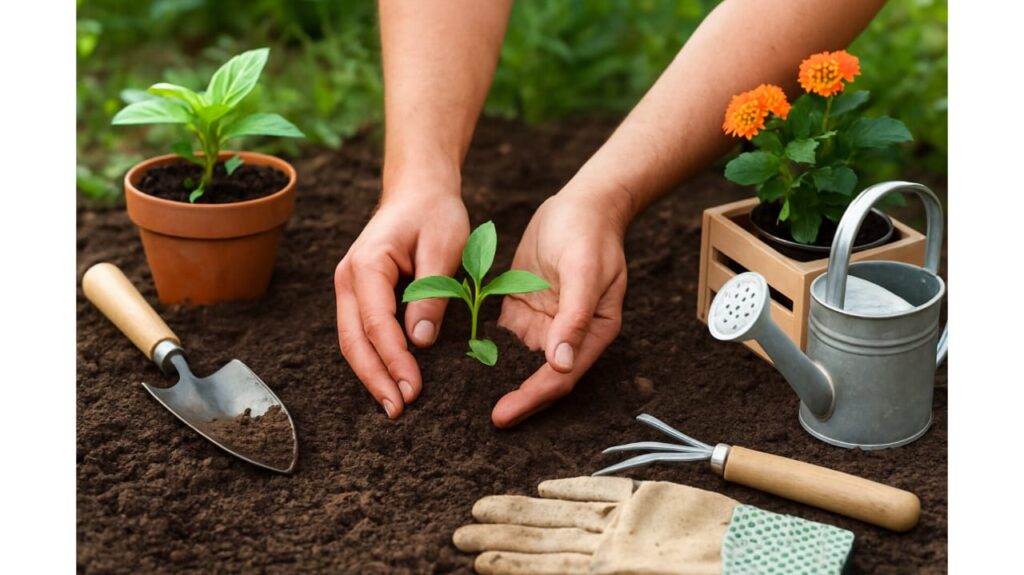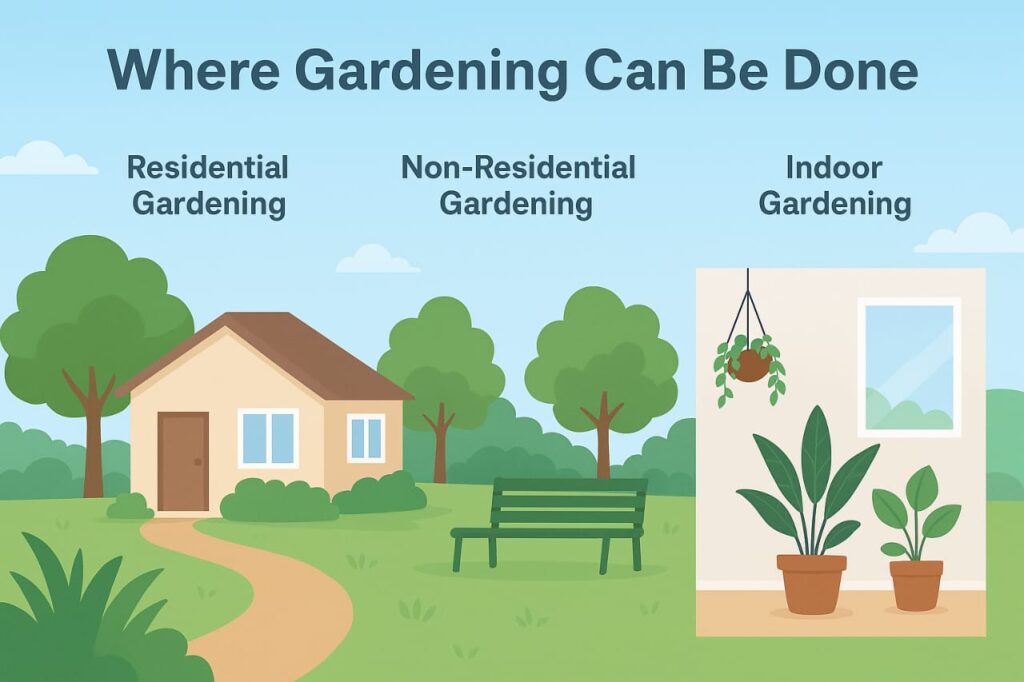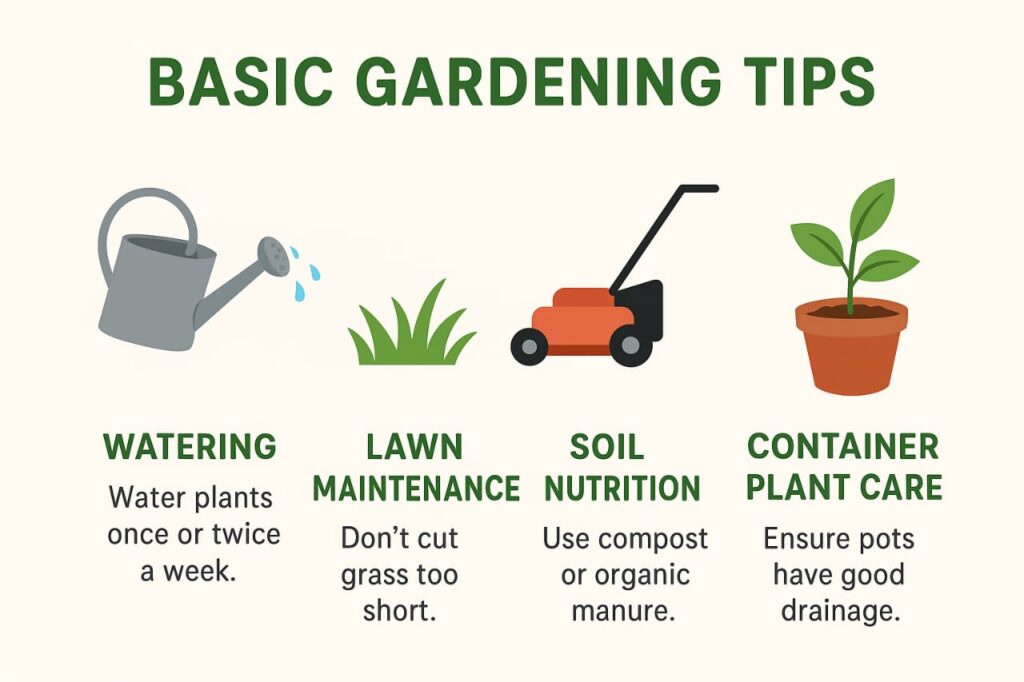Introduction
Gardening is one of the most peaceful and rewarding activities a person can do. It is the practice of growing and cultivating different kinds of plants, trees, shrubs, and flowers. not only makes our surroundings beautiful but also provides us with fruits, vegetables, and a sense of satisfaction. Gardening is an activity where people work directly with soil and plants, caring for them daily by watering, weeding, and trimming. It helps us connect with nature and teaches the value of patience, care, and responsibility. It is not just a hobby; it is an art that combines love for nature with creativity and hard work. Moreover it improves our surrounding.

Meaning and Definition of Gardening
It is defined as the activity of cultivating and growing various plants, bushes, and shrubs in a pleasing manner. Most gardens are made of grass, ornamental plants, and flowers that add colour and beauty to our surroundings. In gardens, ornamental plants are often grown for their beautiful flowers, green leaves, and pleasant appearance. On the other hand, useful plants like root vegetables, leafy vegetables, fruits, and herbs are grown for our use as food, for making natural dyes, or even for medicinal and cosmetic purposes. Gardening can be done on a small scale in our homes or on a large scale in parks and public spaces.
Gardening vs Farming
One major difference between gardening and farming is that gardening is more of a personal and creative activity, while farming is mainly done for commercial production. It involves direct care and attention from the gardener, making it more labour-intensive. It is a relaxing and fulfilling activity where people spend their time nurturing plants and watching them grow. Farming, on the other hand, uses machines and covers larger areas for food production.
Read more Atmosphere
Where Gardening Can Be Done
Gardening can be done almost anywhere, depending on available space and interest.
a) Residential Gardening

Residential gardening takes place near homes in spaces called gardens. These may be located beside a house, on the rooftop, in balconies, patios, or even in window boxes. It adds freshness and beauty to the home environment.
b) Non-Residential Gardening
Non-residential gardening happens in parks, public gardens, botanical gardens, amusement parks, or around hotels and tourist spots. In such places, trained gardeners or ground staff take care of plants and maintain the greenery.
c) Indoor Gardening
Indoor gardening is another popular type where plants are grown inside buildings or homes, often in greenhouses or conservatories. It allows people to enjoy gardening even during cold seasons or in areas without open land.
Types of Gardening
It can be divided into different types based on the place and method used.
a) Native Plant Gardening
This type focuses on using local plants that naturally grow in a particular area. It saves water, reduces maintenance, and supports local wildlife.
b) Water Gardening
This involves growing plants that thrive in water, such as lilies or lotus, often in ponds or small artificial water bodies. Bog gardens are also part of this type.
c) Container Gardening
Plants are grown in pots, baskets, and planters, suitable for balconies, rooftops, or small spaces. It is perfect for people living in apartments.
d) Hugelkultur Gardening
Also known as “mound gardening,” it involves growing plants on piles of rotting wood. It improves soil health and retains moisture for a long time.
Benefits of Gardening
It offers many physical, mental, and environmental benefits.
a) Physical Health Benefits

It is a great form of exercise. Activities like digging, planting, watering, and harvesting help keep our bodies active. It improves flexibility and strength while being gentle on joints. For example, growing herbs at home saves money and adds flavor to meals.
b) Mental Health Benefits
It reduces stress and anxiety. Spending time in nature has a calming effect and helps lower blood pressure. Watching plants grow gives a feeling of achievement and happiness.
- Therefore plants clean the air; therefore, gardening supports good heath.
- As the result, people feel calmer and happier.
- Thus, gardening helps create a peaceful environment.
- Because of this, it reduces stress; because of this, many people take it as therapy.
c) Improves Creativity and Learning
When we plan what to grow, research soil types, and experiment with methods, we sharpen our problem-solving and creative thinking skills. It teaches patience, observation, and continuous learning.
Environmental Importance of Gardening
Plants are vital for the balance of nature. They provide oxygen, food, and maintain the water cycle. Without plants, life on Earth would not exist. It allows everyone to contribute to this balance by planting and caring for trees. Even a small home garden can reduce pollution, control temperature, and provide shelter for birds and insects.
a) Vegetable Gardening
Growing vegetables gives us fresh and organic food. It helps us become self-sufficient and reduces dependence on markets. For example, growing herbs at home saves money and adds flavor to meals.
- Firstly, choose the right soil for your plants
- then, water them reguarly
- afterwards, remove weeds to keep the garden clean.
- finally, enjoy the fresh air and beauty of your garden.
b) Ornamental Gardening
Flowers add colour, fragrance, and happiness to our lives. They are part of every celebration — weddings, birthdays, or festivals. They bring joy and express emotions beautifully.
Gardening and Social Responsibility
Many people consider gardening only a hobby, but it is much more than that. It is our responsibility to protect the environment. Unfortunately, in our busy lives, people often cut trees for buildings but forget to plant new ones. Some blame the government for lack of greenery, but true change begins with us.
The government plants trees along highways and public spaces, but we must also contribute. Even if we cannot plant large trees, we can grow small plants at home or on our rooftops. If we cut one tree, we should plant two more. Small steps can create a big impact.
Basic Gardening Tips
To make gardening more successful, we must take proper care of plants.
a) Watering

Water plants once or twice a week. The best time to water is early morning or late evening when the soil is cool. Avoid watering leaves to prevent mould and always water near the roots.
b) Lawn Maintenance
Do not cut the grass too short, especially in summer. Keep it around five centimetres tall to protect it from sunlight and maintain moisture. Overwatering can cause damage, so water lawns wisely.
c) Soil and Nutrition
Healthy soil is the foundation of good gardening. Use compost or organic manure to keep the soil rich in nutrients. Remove dry leaves and weeds regularly to prevent pests and diseases.
d) Container Plant Care
For container gardening, ensure pots have good drainage. Keep the soil moist and check for proper sunlight. Avoid overwatering and use natural fertilizers for better results.
Gardening for a Greener Planet
It plays a major role in protecting our planet. Trees absorb carbon dioxide and release oxygen, helping to fight climate change. They prevent soil erosion, keep the air clean, and maintain the beauty of nature. When we plant trees, we are investing in a healthy future for the next generation.
Conclusion
It is a beautiful activity that connects humans with nature and keeps us healthy, relaxed, and happy. It teaches patience, creativity, and care. Plants are the lifeline of our planet — they give us food, air, and water. So, gardening is not just about decoration; it is about survival and balance.
As responsible citizens, we should all plant more and more trees. Even a few plants at home can make the Earth greener and cleaner. If every person contributes a little, together we can make our world more peaceful, healthy, and beautiful. Gardening truly makes our planet a better place to live in.
To sum up, it brings beauty, happiness, and balance to life. Overall, gardening connects people with nature. In conclusion, it is essential for health and nature.
